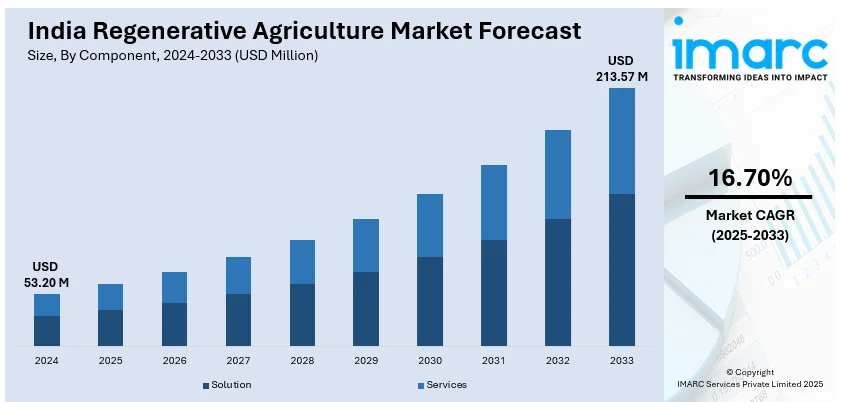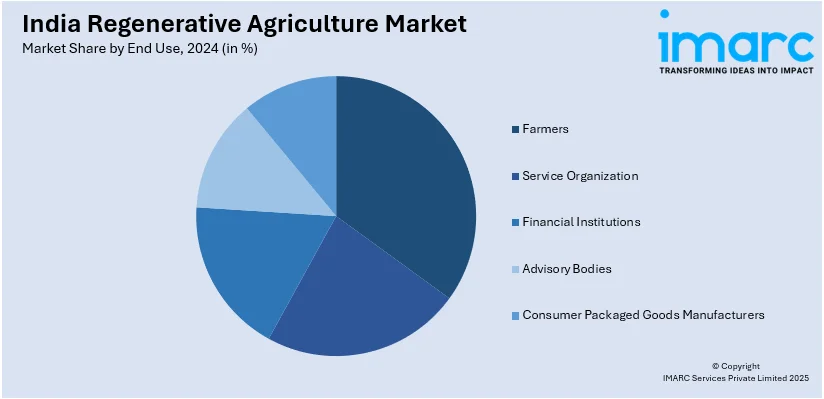
India Regenerative Agriculture Market Size, Share, Trends and Forecast by Component, Type, End Use, and Region, 2025-2033
India Regenerative Agriculture Market Overview:
The India regenerative agriculture market size reached USD 53.20 Million in 2024. Looking forward, IMARC Group expects the market to reach USD 213.57 Million by 2033, exhibiting a growth rate (CAGR) of 16.70% during 2025-2033. The market is driven by government support, increasing consumer demand for organic produce, rising soil degradation concerns, corporate sustainability commitments, expanding carbon credit programs, advancements in agri-tech solutions, growing climate resilience needs, and initiatives promoting biofertilizers, cover cropping, agroforestry, and low-tillage practices for sustainable farming.
|
Report Attribute
|
Key Statistics
|
|---|---|
|
Base Year
|
2024 |
|
Forecast Years
|
2025-2033
|
|
Historical Years
|
2019-2024
|
| Market Size in 2024 | USD 53.20 Million |
| Market Forecast in 2033 | USD 213.57 Million |
| Market Growth Rate (2025-2033) | 16.70% |
India Regenerative Agriculture Market Trends:
Adoption of Carbon Farming and Regenerative Certification Programs
As carbon sequestration becomes a key climate mitigation strategy, carbon farming practices in India are gaining traction. Regenerative agriculture is increasingly being integrated into carbon credit markets, allowing farmers to monetize sustainable land management practices. Companies in food and agribusiness are promoting carbon offset initiatives by partnering with farmers to adopt techniques such as cover cropping, no-till farming, agroforestry, and rotational grazing. Additionally, the rise of regenerative agriculture certification programs is helping farmers access premium pricing in domestic and international markets. Certification standards, including organic-regenerative labels and third-party sustainability audits, are being embraced by agribusiness giants and exporters. These initiatives boost consumer trust, encourage corporate investment, and promote long-term environmental benefits. For example, in March 2023, Diageo India, in partnership with The Nature Conservancy India, launched a three-year regenerative agriculture program in Punjab and Haryana to train 5,000 smallholder farmers. The initiative promotes direct seeding, crop residue management, soil health improvement, and agroforestry to enhance sustainability and farm profitability. Aligned with Diageo’s ‘Spirit of Progress’ ESG goals, the program aims to reduce carbon footprint and improve water quality. This initiative strengthens India’s circular economy approach, ensuring long-term agricultural resilience.

To get more information on this market, Request Sample
Integration of Technology in Regenerative Farming Practice
Technological advancements are redefining regenerative agriculture in India, enabling precision soil management, real-time crop monitoring, and AI-powered decision-making. The integration of remote sensing, IoT-based soil sensors, and AI-driven farm analytics is allowing farmers to optimize resource use while maintaining soil fertility and biodiversity. Additionally, blockchain-powered supply chain solutions are ensuring greater transparency and traceability for regeneratively farmed products, enhancing their credibility in organic and premium food markets. For instance, in February 2025, AgriStack India announced that they are integrating AI and Machine Learning into crop management to enhance yield prediction, disease detection, soil health analysis, and smart irrigation. The system uses satellite imaging, weather forecasts, and AI-driven analytics to help farmers make data-driven decisions and reduce losses. The initiative aims to automate farming recommendations, provide real-time alerts, and optimize resource use. State-wide rollouts are planned by 2026, ensuring targeted subsidies, improved food security, and better agricultural policies. Consequently, such innovations empower farmers to enhance productivity, reduce input costs, and achieve long-term soil regeneration goals.
India Regenerative Agriculture Market Segmentation:
IMARC Group provides an analysis of the key trends in each segment of the market, along with forecasts at the region/country level for 2025-2033. Our report has categorized the market based on component, type, and end use.
Component Insights:
- Solution
- Services
The report has provided a detailed breakup and analysis of the market based on the component. This includes solution and services.
Type Insights:
- Agroforestry
- Silvopasture
- Aquaculture/Ocean Farming
- No-Till and Pasture Cropping
- Holistically Managed Grazing
- Biochar
- Others
A detailed breakup and analysis of the market based on the type have also been provided in the report. This includes agroforestry, silvopasture, aquaculture/ocean farming, no-till and pasture cropping, holistically managed grazing, biochar, and others.
End Use Insights:

- Farmers
- Service Organization
- Financial Institutions
- Advisory Bodies
- Consumer Packaged Goods Manufacturers
A detailed breakup and analysis of the market based on the end use have also been provided in the report. This includes farmers, service organization, financial institutions, advisory bodies, and consumer packaged goods manufacturers.
Regional Insights:
- North India
- South India
- East India
- West India
The report has also provided a comprehensive analysis of all the major regional markets, which include North, South, East, and West India.
Competitive Landscape:
The market research report has also provided a comprehensive analysis of the competitive landscape. Competitive analysis such as market structure, key player positioning, top winning strategies, competitive dashboard, and company evaluation quadrant has been covered in the report. Also, detailed profiles of all major companies have been provided.
India Regenerative Agriculture Market News:
- In June 2023, Cargill and TechnoServe launched the ‘Srishti’ regenerative agriculture program in Davanagere, Karnataka, aiming to transition 25,000 acres of maize farms to sustainable practices over four years. The initiative will empower 10,000 farming households with soil health improvement, water conservation, and climate-resilient farming techniques. By integrating traditional and modern regenerative methods, the program seeks to enhance crop productivity, reduce environmental impact, and improve farmer livelihoods. The partnership aligns with global efforts to scale sustainable agriculture.
- In March 2025, PepsiCo India is strengthening its regenerative agriculture efforts in Uttar Pradesh by integrating AI-driven crop management and soil health initiatives into potato farming. The company collaborates with 27,000 farmers across 14 states, providing high-quality seeds, assured buy-back, and digital farming solutions to enhance sustainability.
- In July 2023, IITM Pravartak and WayCool Foods collaborated to develop the Regenerative Agriculture Sustainable Architecture (RASA) tech stack, aiming to revolutionize sustainable farming practices in India. This initiative integrates innovative agri-tech solutions to improve soil health, resource efficiency, and climate resilience. With government backing and increasing organic farming adoption, regenerative agriculture in India is expanding. The RASA stack will provide farmers with advanced technical solutions to enhance sustainability, boost productivity, and combat climate change.
India Regenerative Agriculture Market Report Coverage:
| Report Features | Details |
|---|---|
| Base Year of the Analysis | 2024 |
| Historical Period | 2019-2024 |
| Forecast Period | 2025-2033 |
| Units | Million USD |
| Scope of the Report |
Exploration of Historical Trends and Market Outlook, Industry Catalysts and Challenges, Segment-Wise Historical and Future Market Assessment:
|
| Components Covered | Solution, Services |
| Types Covered | Agroforestry, Silvopasture, Aquaculture/Ocean Farming, No-Till and Pasture Cropping, Holistically Managed Grazing, Biochar, Others |
| End Uses Covered | Farmers, Service Organization, Financial Institutions, Advisory Bodies, Consumer Packaged Goods Manufacturers |
| Regions Covered | North India, South India, East India, West India |
| Customization Scope | 10% Free Customization |
| Post-Sale Analyst Support | 10-12 Weeks |
| Delivery Format | PDF and Excel through Email (We can also provide the editable version of the report in PPT/Word format on special request) |
Key Benefits for Stakeholders:
- IMARC’s industry report offers a comprehensive quantitative analysis of various market segments, historical and current market trends, market forecasts, and dynamics of the India regenerative agriculture market from 2019-2033.
- The research report provides the latest information on the market drivers, challenges, and opportunities in the India regenerative agriculture market.
- Porter's Five Forces analysis assist stakeholders in assessing the impact of new entrants, competitive rivalry, supplier power, buyer power, and the threat of substitution. It helps stakeholders to analyze the level of competition within the India regenerative agriculture industry and its attractiveness.
- Competitive landscape allows stakeholders to understand their competitive environment and provides an insight into the current positions of key players in the market.
Key Questions Answered in This Report
The regenerative agriculture market in India was valued at USD 53.20 Million in 2024.
The India regenerative agriculture market is projected to exhibit a CAGR of 16.70% during 2025-2033, reaching a value of USD 213.57 Million by 2033.
The India regenerative agriculture market is driven by increasing environmental awareness, the need for sustainable farming practices, and growing concerns over soil health and biodiversity. Government support for eco-friendly agriculture, rising demand for organic produce, and climate change impacts also promote adoption. Additionally, farmers’ interest in long-term productivity and resource conservation supports the market growth.
Need more help?
- Speak to our experienced analysts for insights on the current market scenarios.
- Include additional segments and countries to customize the report as per your requirement.
- Gain an unparalleled competitive advantage in your domain by understanding how to utilize the report and positively impacting your operations and revenue.
- For further assistance, please connect with our analysts.
 Request Customization
Request Customization
 Speak to an Analyst
Speak to an Analyst
 Request Brochure
Request Brochure
 Inquire Before Buying
Inquire Before Buying




.webp)




.webp)












